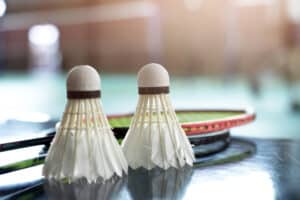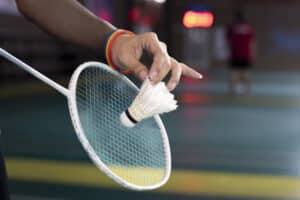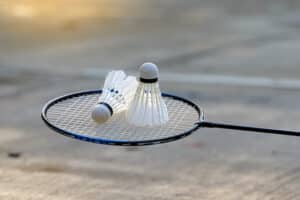Can You Play Badminton on Concrete?
Key Takeaways
- Playing badminton on concrete is generally considered unsafe due to the hard and unforgiving surface, which increases the risk of injuries such as joint strain and sprains.
- Concrete courts offer limited traction, making it difficult to move and run swiftly, and dust accumulation can affect gameplay and increase the risk of slips or falls.
- Precautions can be taken to make playing badminton on concrete more comfortable and safer, such as wearing proper footwear, using a softer shuttlecock, finding a smoother surface, and taking necessary precautions like stretching and warming up.
Badminton is a popular sport enjoyed by people of all ages and skill levels. While it is typically played on designated courts with appropriate flooring, there may be occasions when playing on concrete becomes a necessity. However, is it safe to play badminton on concrete? Let’s explore the various perspectives and considerations.
Is Playing Badminton on Concrete Safe?
According to multiple sources, playing badminton on concrete is generally considered unsafe. Concrete surfaces are hard and unforgiving, which can lead to increased risk of injuries to players. The lack of shock absorption can result in discomfort, joint strain, and potential sprains.
Furthermore, concrete courts offer limited traction, making it difficult to move and run swiftly on the surface. Dust accumulation is another issue that may affect gameplay and increase the risk of slips or falls.
Transitioning from playing on concrete to other court surfaces, such as wood or synthetic, may also pose challenges for players accustomed to concrete courts.
Minimizing the Risks of Playing on Concrete
While playing badminton on concrete is generally discouraged, there are some measures you can take to minimize the risks and make it safer:
- Wear proper footwear: Choose shoes with good cushioning and support to reduce the impact on your feet and joints. This can help minimize discomfort and potential injuries.
- Use a softer shuttlecock: Opt for shuttlecocks with a softer cork to minimize the damage caused by the hard court surface. This can help prolong the lifespan of the shuttlecocks.
- Find a smoother surface: Look for a concrete court with a smoother surface, as this can help reduce the shock on your feet and joints.
- Take necessary precautions: Stretch properly before playing, warm up your body, and listen to your body’s signals to avoid overexertion or strain.
These precautions can help make playing badminton on concrete more comfortable and safer, but it is still important to remain mindful of the inherent risks associated with this surface.
Pros and Cons of Playing Badminton on Concrete
Playing badminton on concrete has its own set of advantages and disadvantages:
Pros:
- Budget-friendly option for outdoor badminton courts.
- Suitable for casual or recreational play.
- One-time investment for court construction.
- Durable surface that can withstand heavy use.
- Provides good ball bounce.
- Easy to set up and doesn’t require additional equipment.
- Concrete courts are usually cheap and easy to find.
Cons:
- Concrete surfaces can be hard and lack shock absorption, increasing the risk of injuries like cramps and sprains.
- Limited traction, making it difficult to move and run on the court.
- Dust easily accumulates on the surface, affecting gameplay.
- Transitioning to a different court surface may be challenging for players accustomed to concrete courts.
- Hard surface can be tough on feet and joints.
- Shuttlecocks may suffer more damage and require more frequent replacement.
Conclusion
In conclusion, while it is possible to play badminton on concrete, it is generally not recommended due to the increased risk of injuries and discomfort. Concrete surfaces lack shock absorption and traction, making it challenging to move swiftly and increasing the likelihood of accidents. However, if you must play on concrete, following the aforementioned precautions can help minimize the risks. It is important to prioritize safety and consider alternative court surfaces whenever possible.
Related Websites:
- Sports Stack Exchange – How to Avoid Injuries Playing Badminton on Concrete Floor
- Do Your Spin – Outdoor Badminton Court
- Badminton Ace – Can We Play Badminton on Concrete Floor?
- Sports Venue Calculator – Pros and Cons of Playing on Different Badminton Court Surface Types at Different Levels
- Court Dimensions – How to Build a Badminton Court
FAQs:
Q: Can badminton be played on concrete?
Yes, badminton can be played on concrete. However, it is not the ideal surface for the sport.
Q: What are the pros and cons of playing badminton on concrete?
Playing badminton on concrete offers the advantage of a solid and stable surface. However, it can be harsh on the joints and may lead to a faster wear and tear of the shuttlecock and rackets.
Q: How does playing badminton on concrete impact gameplay and player experience?
Playing on concrete may result in a faster game pace due to the reduced grip and shuttlecock bounce. It can also cause more strain on the body, potentially affecting player performance and enjoyment.
Q: What are the recommended alternative playing surfaces for badminton?
The recommended alternative playing surfaces for badminton include indoor wooden courts and outdoor synthetic courts. These surfaces provide better cushioning, grip, and shuttlecock bounce.
Q: How can players make informed decisions about playing surfaces in badminton?
Players should consider their preferences, circumstances, and the impact on their gameplay and comfort. It is advisable to try different surfaces and consult with experienced players or coaches to make an informed decision.






